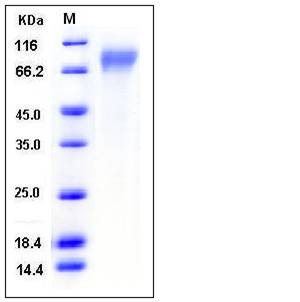Human CD30 / TNFRSF8 Protein (His Tag)
CD30,D1S166E,Ki-1
- 100ug (NPP1140) Please inquiry
| Catalog Number | P10777-H08H |
|---|---|
| Organism Species | Human |
| Host | Human Cells |
| Synonyms | CD30,D1S166E,Ki-1 |
| Molecular Weight | The secreted recombinant human TNFRSF8 consists of 372 amino acids and has a predicted molecular mass of 40 kDa. In SDS-PAGE under reducing conditions, the apparent molecular mass of rhTNFRSF8 is approximately 75-90 kDa due to glycosylation. |
| predicted N | Phe 19 |
| SDS-PAGE |  |
| Purity | > 97 % as determined by SDS-PAGE |
| Protein Construction | A DNA sequence encoding the human TNFRSF8 (NP_001234.2) extracellular domain (Met 1-Lys 379) was expressed, fused with a polyhistidine tag at the C-terminus. |
| Bio-activity | 1. Measured by its binding ability in a functional ELISA. 2. Immobilized recombinant human CD30 at 2 μg/ml (100 μl/well) can bind human CD30L Fc Chimera with a linear range of 6.4-800 ng/ml. |
| Research Area | Immunology |Innate Immunity |Natural Killer Cell (NK Cell) |
| Formulation | Lyophilized from sterile PBS, pH 7.4 1. Normally 5 % - 8 % trehalose, mannitol and 0.01% Tween80 are added as protectants before lyophilization. Specific concentrations are included in the hardcopy of COA. |
| Background | CD30, also known as TNFRSF8, is a cell membrane protein of the tumor necrosis factor receptor (TNFR) superfamily. CD30 protein is expressed by activated, but not resting, T and B cells. CD30 can regulate proliferation of lymphocytes and may also play an important role in human immunodeficiency virus replication. As a regulator of apoptosis, CD30 protein induces cell death or proliferation, depending on the cell type, and has been shown to limit the proliferative potential of autoreactive CD8 effector T cells and protect the body against autoimmunity. CD30 protein expression is upregulated in various hematological malignancies, including Reed-Sternberg cells in Hodgkin's disease (HD), anaplastic large cell lymphoma (ALCL) and subsets of Non-Hodgkin's lymphomas (NHLs), and CD30 is also linked to leukocytes in patients with chronic inflammatory diseases, including lupus erythematosus, asthma, rheumatoid arthritis and atopic dermatitis (AD). |
| Reference |
